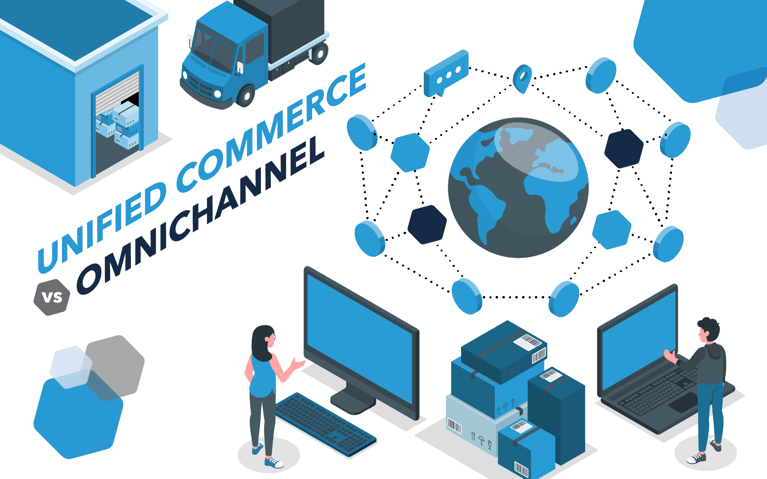This is an excerpt from Cart.com’s newest eBook “Scaling with unified commerce: A step-by-step guide,” an in-depth look at unified commerce, how it compares to other commerce strategies and how to implement a unified commerce strategy. Check out the full eBook here.
Part 3: Implementing your unified commerce strategy
Unified commerce is about making your data work together and accessing it from a single source of truth. It’s seamlessly fusing all channels and touchpoints to deliver a consistent shopping journey for customers, merging the physical and digital for a frictionless path that leads from discovery to delivery. It eliminates discordant tech stacks and replaces them with a strong, streamlined interconnection.
Implementing a unified commerce strategy within a business requires careful planning and execution to ensure success. The process involves several key steps that guide the organization toward its objectives. From initial goal setting to monitoring and adjusting, each phase plays a crucial role in achieving desired outcomes. By diligently following these steps, businesses can translate their strategic vision into actionable plans and tangible results. To implement your strategy:
Integrate your sales channels
Integrating your sales channels means aligning various platforms and channels to both streamline operations and provide a cohesive customer experience. To integrate sales channels effectively:
- Assess current channels: Begin the process by evaluating existing sales channels, such as online stores, brick-and-mortar locations, marketplaces and social media platforms.
- Choose integration tools: Select integration tools or platforms that allow seamless communication between different channels. This may include ecommerce platforms, CRM systems or ERP software.
- Centralize inventory management: Implement a centralized inventory management system that tracks stock levels across all channels in real time. This ensures accurate inventory counts and prevents overselling or stockouts. It also gives consumers correct product availability and helps with demand forecasting.
- Sync product information: Maintain consistency in product information, pricing and availability across all sales channels. Use product information management (PIM) software to update product details efficiently.
- Enable cross-channel visibility: Give consumers visibility into inventory availability, order status and shipping options across all channels. This enhances transparency and improves the overall shopping experience.
- Implement unified analytics: Utilize analytics tools that gather data from all sales channels to gain insights into customer behavior, sales performance and channel effectiveness. This data-driven approach enables informed decision-making and optimization.
- Train staff: Train employees to effectively manage integrated sales channels. Provide comprehensive training on using integrated systems, handling customer inquiries and maintaining consistent branding across channels.
- Monitor and adapt: Continuously monitor sales channel performance and customer feedback to identify areas for improvement. Adapt your integration strategy based on evolving market trends and customer preferences.
Successful sales channel integration creates a seamless and efficient omnichannel experience for customers while maximizing sales opportunities across all touchpoints.
Connect your fulfillment channels
Connecting fulfillment channels involves integrating various systems and processes to ensure efficient order fulfillment across different channels. Using the same provider for retail, ecommerce and wholesale operations is also helpful. To connect your fulfillment channels effectively:
- Optimize order fulfillment: Streamline order fulfillment processes by integrating order management systems with shipping carriers and fulfillment centers. This enables faster order processing and shipment tracking.
- Use a centralized fulfillment system: Select a centralized fulfillment system or software that can manage orders from all sales channels in one place. This system should support integration with ecommerce platforms, marketplaces and other sales channels.

- Integrate ecommerce platforms: Integrate your ecommerce platforms with the fulfillment system to automatically sync orders, inventory levels and shipping information. This integration ensures that orders are processed promptly and accurately.
- Link inventory management systems: Connect your inventory management system to the fulfillment system to maintain real-time visibility of stock levels across all fulfillment channels. This prevents overselling and stockouts while optimizing inventory allocation.
- Sync shipping carriers: Integrate shipping carrier services with the fulfillment system to streamline the shipping process. This allows you to generate shipping labels, track shipments and provide customers shipping options directly from the fulfillment system.
- Automate order routing: Implement automated order routing rules to optimize order processing. Assign orders to the nearest fulfillment center or warehouse based on inventory availability and shipping preferences.
- Implement pick-pack-ship workflows: Standardize your pick-pack-ship workflows across all fulfillment channels to streamline operations. Use barcode scanning and automation tools to increase efficiency and reduce errors during order fulfillment.
- Provide cross-channel visibility: Offer customers visibility into their order status and shipment tracking information. Integrate order status updates and tracking links into confirmation emails and customer accounts for a seamless experience.
- Monitor performance and optimize: Monitor fulfillment channel performance metrics such as order processing time, perfect order rate, shipping costs and other helpful KPIs. Use this data to identify bottlenecks, optimize processes and improve overall fulfillment efficiency.

By connecting your fulfillment channels effectively, you can ensure consistent and efficient order fulfillment operations across all sales channels, leading to improved customer satisfaction and increased sales opportunities.
Market your brand consistently
It’s an important reminder for retail businesses that consistent brand presentation across all platforms increases revenue by up to 10-20%.1 Consistent marketing is also an integral part of your unified commerce strategy. When critically assessing your brand marketing efforts, ask yourself:
Brand identity
|
Messaging consistency
|
Audience targeting
|
Content alignment
|
Visual branding
|
Customer experience
|
Channel integration
|
Feedback and measurement
|
By asking these questions and evaluating your marketing efforts, you can assess the level of consistency in promoting your brand and identify areas for improvement to ensure a unified brand experience for your audience.
But you must also be consistent in your marketing efforts, including maintaining a regular schedule for campaigns and content. This fosters brand trust and reliability among consumers. A consistent presence helps reinforce brand awareness and recognition, keeping your brand top-of-mind for potential customers. By delivering content and campaigns consistently, you can establish a cohesive brand identity and messaging, ultimately driving engagement, loyalty and long-term success.
Make sure your entire team is on board
One of the benefits of using a unified commerce model is having incredibly accurate data. Users that are thought to be two different customers when looking at separate systems are often one single customer when viewed through the unified commerce lens.
With this new and improved collection of data, it's essential that everyone on your team - from marketing and sales to analysts - are all making informed decisions using the same data. It should be your central data source (your single source of truth!). It's better for your bottom line and will prevent confusion between teams.
Once unified, craft a seamless customer experience
The customer experience is central to unified commerce, serving as the cornerstone for creating seamless and cohesive interactions across all channels. Unified commerce is about providing consistent and personalized experiences, regardless of how consumers engage with your brand. This means prioritizing a customer-centric approach, the catalyst for customer satisfaction, loyalty and retention. It’s the building blocks for sustainable growth and gaining a competitive advantage. Unified commerce lets you be flexible, adaptive, resilient and focused on your customer and their journey. To craft the customer experience:
Map your customer journey
A survey found that 66% of customers expect companies to understand their needs.2 Retailers can learn a lot about their customers, their experiences, preferences, challenges and needs by mapping their journey. With access to the data a unified commerce approach provides, you can delve deep into the touchpoints, interactions and feelings online and offline throughout the stages of awareness, consideration, purchase, retention and advocacy. To map the journey:
- Identify all potential touchpoints across various channels, including online platforms, social media, physical stores and customer service channels. This involves understanding how customers become aware of your brand, research products or services, make purchasing decisions and engage with your brand after purchase.
- Gather data to analyze customer behaviors and preferences at each stage of the journey. This may involve collecting data from customer interactions, surveys, website analytics and sales records. By analyzing this data, you can identify patterns, pain points and opportunities for improvement in the customer experience.
- Create visual representations of the customer journey map, such as flowcharts or diagrams, to illustrate the different stages and touchpoints. These maps should outline the customer's actions, emotions, motivations and pain points at each stage, providing a holistic view of their experience.
- With the customer journey map in hand, identify areas where the experience can be enhanced or optimized to meet customer needs and expectations better. This may involve streamlining processes, improving communication channels or introducing personalized experiences tailored to specific customer segments.
- Iterate and refine the customer journey map regularly based on customer feedback and insights gathered from ongoing data analysis. The customer journey is dynamic and may evolve over time, so it's essential to continuously monitor and adapt your strategies to ensure they align with changing customer preferences and market trends.
Overall, mapping the customer journey is a valuable tool for businesses looking to gain a deeper understanding of their customers’ experiences and identify opportunities for improvement. The experience should be optimized from the moment of the first interaction through purchase and post-purchase to interactions beyond delivery.
Continue to adjust
Whether you focus on finding a 3PL partner that can handle your growing business and omnichannel fulfillment needs or reducing friction between channels, your strategies, processes and decisions should be made using unified data and keeping your customer in mind. Even when objectives are achieved, brands can’t remain static. They must continue to adjust to meet evolving needs, stay on-trend and remain competitive – which is easier using a unified commerce approach.
Want to learn more? Check out the rest of our eBook about unified commerce – along with strategies and best practices to implement and scale with a unified commerce approach.
Subscribe to our emails for the latest industry insights!
By entering your email, you agree to receive marketing emails from Cart.com







